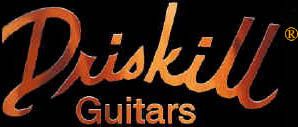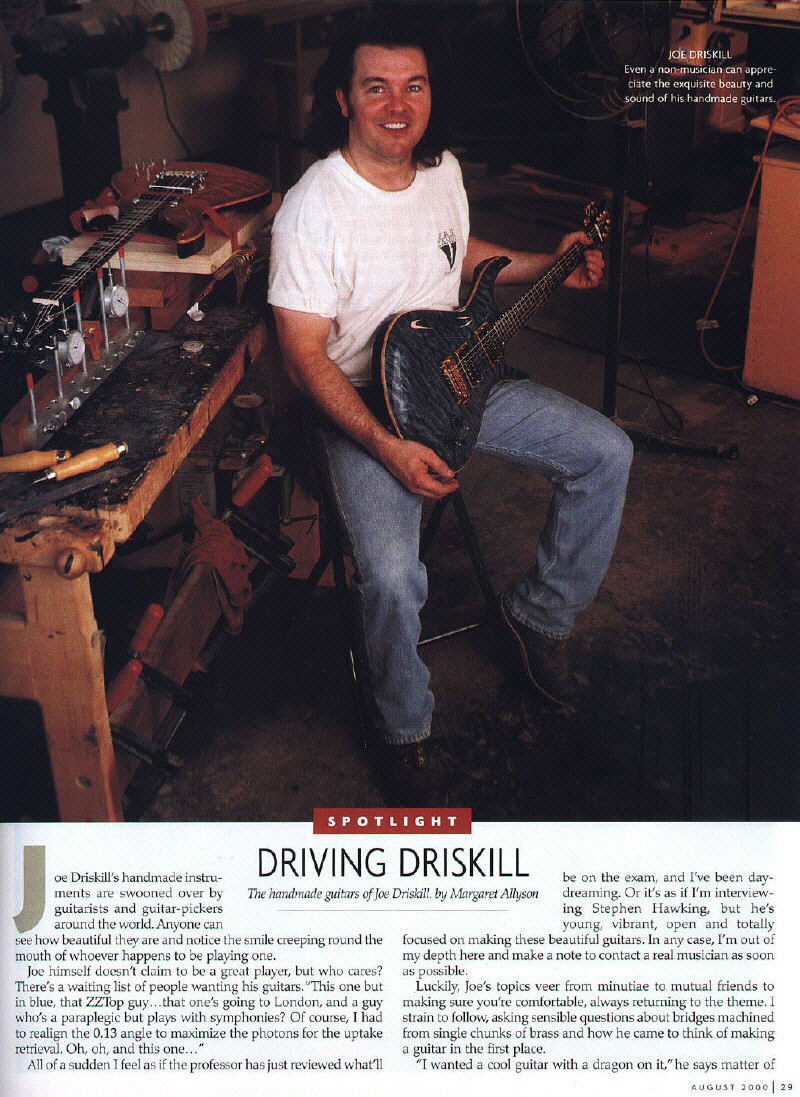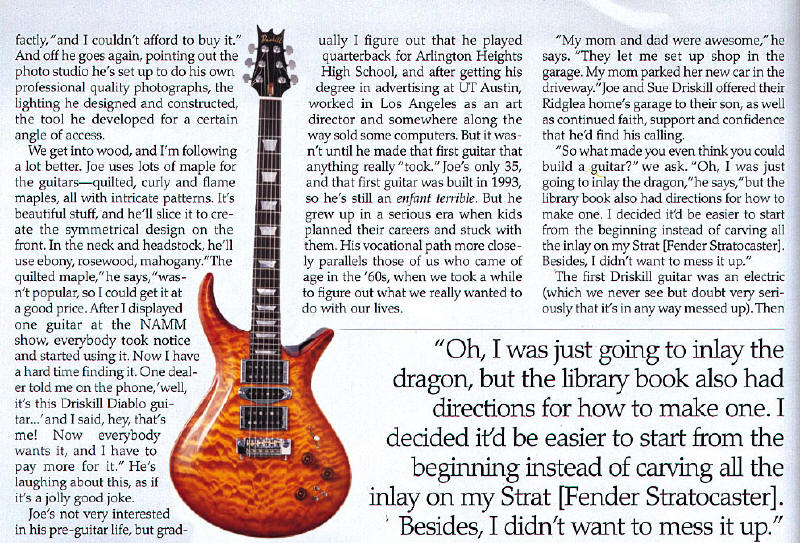

| Here is a reprint of a magazine article on Driskill Guitars. The text is reprinted at the bottom in case the scanned text is too hard to read. |



|
Joe
Driskill’s handmade instruments are swooned over by guitarists and
guitar-pickers around the world. Anyone can see how beautiful they are and
notice the smile creeping round the mouth of whoever happens to be playing
one. Joe
himself doesn’t claim to be a great player, but who cares? There’s a
waiting list of people wanting his guitars. “This one but in blue, that
ZZTop guy…that one’s going to London, and a guy who’s a paraplegic
but plays with symphonies? Of course, I had to realign the 0.13 angle to
maximize the photons for the uptake retrieval. Oh, oh, and this one…” All
of a sudden I feel as if the professor has just reviewed what’ll be on
the exam, and I’ve been daydreaming. Or it’s as if I’m interviewing
Stephen Hawking, but he’s young, vibrant, open and totally focused on
making these beautiful guitars. In any case, I’m out of my depth here
and make a note to contact a real musician as soon as possible. Luckily,
Joe’s topics veer from minutiae to mutual friends to making sure
you’re comfortable, always returning to the theme. I strain to follow,
asking sensible questions about bridges machined from single chunks of
brass and how he came to think of making a guitar in the first
place. “I
wanted a cool guitar with a dragon on it,” he says matter of factly,
“and I couldn’t afford to buy it.” And off he goes again, pointing
out the photo studio he’s set up to do his own professional quality
photographs, the lighting he designed and constructed, the tool he
developed for a certain angle of access. We
get into wood, and I’m following a lot better. Joe uses lots of maple
for the guitars—quilted, curly and flame maples, all with
intricate patterns. It’s beautiful stuff, and he’ll slice it to create
the symmetrical design on the front. In the neck and headstock, he’ll
use ebony, rosewood, mahogany. “The quilted maple,” he says,
“wasn’t popular, so I could get it at a good price. After I displayed
one guitar at the NAMM show, everybody took notice and started using it.
Now I have a hard time finding it. One dealer told me on the phone,
‘well, it’s this Driskill Diablo guitar...’ and I said, hey,
that’s me! Now everybody wants it, and I have to pay more for it.”
He’s laughing about this, as if it’s a jolly good joke. Joe’s
not very interested in his pre-guitar life, but gradually I figure
out that he played quarterback for Arlington Heights High School, and
after getting his degree in advertising at UT Austin, worked in Los
Angeles as an art director and somewhere along the way sold some
computers. But it wasn’t until he made that first guitar that
anything really “took.” Joe’s only 35, and that first guitar
was built in 1993, so he’s still an enfant
terrible. But he grew up in a serious era when kids planned their
careers and stuck with them. His vocational path more closely parallels
those of us who came of age in the ’60s, when we took a while to
figure out what we really wanted to do with our lives. “My
mom and dad were awesome,” he says. “They let me set up shop in the
garage. My mom parked her new car in the driveway.” Joe and Sue Driskill
offered their Ridglea home’s garage to their son, as well as continued
faith, support and confidence that he’d find his calling. “So
what made you even think you could build a guitar?” we ask. “Oh, I was
just going to inlay the dragon,” he says, “but the library book also
had directions for how to make one. I decided it’d be easier to start
from the beginning instead of carving all the inlay on my Strat [Fender
Stratocaster]. Besides, I didn’t want to mess it up.” The
first Driskill guitar was an electric (which we never see but doubt
very seriously that it’s in any way messed up). Then Joe turned to
acoustic for a while after that first one, the dragon inlaid with
abalone. “Which I hand-cut with a jeweler’s saw,” he laughs. Because
Joe has progressed from fine handwork done with minimal tools
through new technologies, even the computerized and automated processes he
now employs are informed by fine craftsmanship. Nothing is done for
a shortcut that would compromise the integrity of the Driskill guitar. And
they are amazing, even to a non-musician. Silver and gold, abalone and
mother-of-pearl inlays fit perfectly into the glowing wood. Joe
loaded up a car full of electric guitars in early 1998 and headed west for
his first show—the National Association of Music Merchants. Every
one of his guitars sold quickly, and the young man gathered immediate
attention. “Paul Reed Smith came up to me,” Joe says proudly,
referring to a well-known master about 10 years older than Joe. “He
played my guitar. He loved it, said I was exactly where he was 10 years
ago. That’s high praise. Then this band called Moss flew me and a
guitar back to California later so they could record with it. It was a big
deal. Steven Spielberg had something to do with it.” And then Joe says,
“Billy Gibbons.” What? “That’s the guy with ZZTop,” he answers.
“Who wants one of these. Might want a biker girl painted on it.” He
laughs some more. What
people really want, it seems, is the best-selling Driskill Diablo™ in
blue, purple or green. Or the Diablo Blues™. The vine inlay is the
favorite, despite the occasional art lover’s special request. And
they’re willing to part with thousands of dollars to get one. Or to
enter a life of crime. Joe’s excited today because one of his guitars,
stolen some time ago from a collector by a thief who took only the
Driskill from the group, has been spotted at an area pawn shop. The true
owner’s off to retrieve his baby. And
I’m off to enlist Fred Dittman, area musician, to clarify just what
makes these guitars so desirable. I still don’t understand all the
techno language. They look really cool though. Joe has quit working with
dealers who were charging overinflated prices for his guitars and is
selling most of his wares through word-of-mouth and on the Internet. Go to
www.driskillguitars.com to see what the excitement is all about. |
|